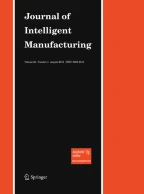Abstract
Logistics networks that are currently formed by supply chains are intertwined but remain heterogeneous and not very interconnected. In computer networks, this stage was overtaken with the arrival of Internet. In this paper we explore the possible analogies and transpositions between computer networks, in particular Internet, and logistic networks. To this end, a new logistical concept was proposed: Physical Internet that aims at the interconnection of networks of logistic services. In fact, there are strong similarities between these networks in spite of the basic differences in the type of objects that prevent an integral transposition. To illustrate the pertinence of this analogy, the authors illustrate the interconnection potential of logistics networks with a stylised model. In view of the exploratory nature of this work, this impact will be assessed by means of an analytic model based on a method of continuous approximations. This illustration provides an indication of the potential inherent in the interconnection of logistics networks.
Similar content being viewed by others
References
Antonelli, D., & Caroleo, B. (2011). An integrated methodology for the analysis of collaboration in industry networks. Journal of Intelligent Manufacturing, 1–8. doi:10.1007/s10845-011-0510-z.
Ballot E., Fontane F. (2008) Rendement et efficience du transport: un nouvel indicateur de performance. Revue Française de Gestion Industrielle 27(2): 41
Ballot E., Fontane F. (2010) Reducing greenhouse gas emissions through the collaboration of supply chains: Lessons from French reatail chains. Production, Plannig & Control 21: 640–650
Ballot, E., Glardon, R., et al. (2010). Rapport Open Fret: Contribution à à la conceptualisation et à à la réalisation d’un Hub Rail_Route de l’Internet Physique. M. C. 52. PREDIT: Programme de recherhe et d’innovation dans les trasports terrestres.
Boissieu, C. (2006). Division par quatre des émissions de gaz à à effet de serre de la France à à l’horizon 2050, Ministère de l’Ecologie et du développement durable.
Bontekoning Y., Priemus H. (2004) Breakthrough innovations in intermodal freight transport. Transportation Planning and Technology 27(5): 335–345
Camarinha-Matos L. M., Afsarmanesh H. (2005) Collaborative networks: A new scientific discipline. Journal of Intelligent Manufacturing 16(4): 439–452. doi:10.1007/s10845-005-1656-3
Camarinha-Matos L. M., Afsarmanesh H. (2007) A comprehensive modeling framework for collaborative networked organizations. Journal of Intelligent Manufacturing 18(5): 529–542. doi:10.1007/s10845-007-0063-3
Cheikhrouhou N., Piot G. et al (2010) A multi-criteria model for the evaluation of business benefits in horizontal collaborative networks. Journal of Intelligent Manufacturing 21(3): 301–309. doi:10.1007/s10845-008-0181-6
Chopra S., Meindl P. (2004) Supply chain mangement: Strategy, planning and operation. Prentice Hall, Englewood Cliffs, NJ
Citepa (2009). Substances relatives à à l’accroissement de l’effet de serre. Emissions dans l’air en France. France: Centre Interprofessionnel Techniques d’Etudes de la Pollution Atmosphérique.
Comer D. E., Stevens D. L. (1982) Internetworking with TCP/IP. Prentice-Hall, Englewood Cliffs, NJ
Cruijssen F., Cools M. et al (2007) Horizontal cooperation in logistics: Opportunities and impediments. Transportation Research Part E: Logistics and Transportation Review 43(2): 129–142
Daganzo C. F. (1984) The distance traveled to visit N points with a maximum of C stops per vehicle: An analytic model and an application. Transportation Science 18(4): 331–350
Daganzo C. F. (2005) Logistics systems analysis. Springer, Berlin
European Commission (2008). Methodologies used in surveys of road freight transport in member states and candidate countries. Luxembourg: Eurostat.
Groothedde B., Ruijgrok C. et al (2005) Towards collaborative, intermodal hub networks: A case study in the fast moving consumer goods market. Transportation Research Part E: Logistics and Transportation Review 41(6): 567–583
Hardy D., Malléus G. et al (2002) Networks: Internet, telephony, multimedia: convergences and complementarities. Springer, Berlin
Huitema C. (1999) Routing in the Internet. (2nd ed.). Prentice Hall, Englewood Cliffs, NJ
Le, T., & Lee, T. R. (2011). Model selection with considering the CO2 emission alone the global supply chain. Journal of Intelligent Manufacturing. doi:10.1007/s10845-011-0613-6
McKinnon A., Ge Y. et al (2003) Analysis of transport efficiency in the UK food supply chain. Logistics Research Centre Heriot-Watt University, Edinburgh
McKinnon A. C., Piecyk M. I. (2009) Measurement of CO2 emissions from road freight transport: A review of UK experience. Energy Policy 37(10): 3733–3742
Montreuil, B. (2010). Physical Internet Manifesto V1.7: Globally transforming the way physical objects are handled, moved, stored, realized, supplied and used [Online]. Québec, CA.
Montreuil, B., Meller, R., et al. (2010). Towards a Physical Internet: The impact on logistics facilities and material handling systems design and innovation. In K. Gue et al. (Eds.), Progress in material handling research. Material Handling Industry of America.
Pan, S., Ballot, E., et al. (2010). The reduction of greenhouse gas emissions from freight transport by pooling supply chains. International Journal of Production Economics. in Press, corrected Proof.
Peterson L. L., Davie B. S. (2003) Computer networks: A systems approach. Morgan Kaufmann, Los Altos, CA
Piecyk M. I., McKinnon A. C. (2010) Forecasting the carbon footprint of road freight transport in 2020. International Journal of Production Economics 128(1): 31–42
Stefanovic D., Stefanovic N. (2008) Methodology for modeling and analysis of supply networks. Journal of Intelligent Manufacturing 19(4): 485–503. doi:10.1007/s10845-008-0098-0
Stevens W. R. (1994) TCP/IP illustrated: The protocols. Addison-Wesley Professional, Reading, MA
Stewart J. W. III (1998) BGP4: Inter-domain routing in the Internet. Addison-Wesley Longman Publishing Co., Inc, Reading, MA
Tanenbaum A. S. (2003) Computer networks. (4th ed.). Prentice Hall, New Jersey
Author information
Authors and Affiliations
Corresponding author
Rights and permissions
About this article
Cite this article
Sarraj, R., Ballot, E., Pan, S. et al. Analogies between Internet network and logistics service networks: challenges involved in the interconnection. J Intell Manuf 25, 1207–1219 (2014). https://doi.org/10.1007/s10845-012-0697-7
Received:
Accepted:
Published:
Issue Date:
DOI: https://doi.org/10.1007/s10845-012-0697-7
